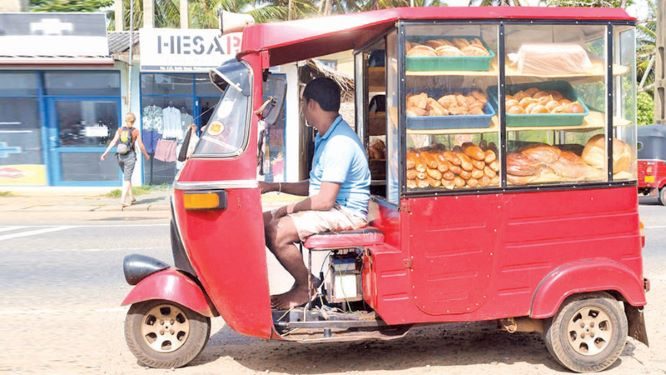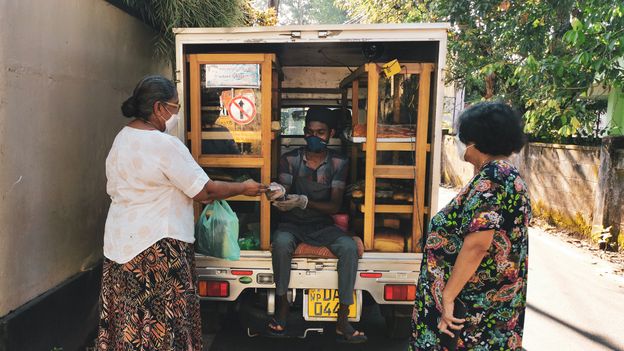Street vendors’ survival instinct sees them through the pandemic
Posted on September 17th, 2020
By Dr. Lopamudra Maitra Bajpai Courtesy NewsIn.Asia
During the lockdown in Sri Lanka, the rich and the poor alike got their daily bread from the humble itinerant “choon paan” man

Street vendors and hawkers are ubiquitous part of everyday business. The secret of their survival even under stressful conditions is that they are very adaptable to changing conditions. And they have been around for a long, long time, from the era of the ‘The Jataka’ and ‘The Panchatantra’. They are also part of the modern popular culture, being shown in cartoons, animation movies and advertisements. And they are seen all over South Asia.
Rabindranath Tagore’s Bengali poem- ‘Bichitra Sadh’ (Vocation), is about the wish of a child to be a street vendor when he grows up. In Sri Lanka street hawkers are on by-cycles or auto-rickshaws tuk-tuks- peddling Lamprais, a Dutch-Lankan dish which is a mix of steamed rice, served with a curry of fish or chicken, along with other curries made with vegetables, lentils, or fruits and a spoonful of pickled fruits or vegetables, chutneys, and sambol. Other popular street vendor are those who sell Bombai Muttai, fluffy coloured candy, a candy floss as it were. Still more interesting are the ‘choon paan’ trucks- plying in the early mornings and evenings. These are the famous bread-trucks and bun combo known as choon paan” loosely translates to music bread” in Sinhala. These are driven by men, who would play a song on a CD player, blaring out of a loudspeaker. This was their unique method of advertising and this was their method of letting the neighbourhood know about their arrival.
Interestingly enough, a closer look at the methods of selling also reveals distinct traits. While the streets of Colombo had the bakers selling their products, using a CD player with a Hindi film number or more interestingly, Fur Elise the bakers at other remote regions would often have a different repertoire, where Fuer Elise would be supplemented with the traditional, mellifluous tune from a flute. I remember listening to one such ‘choon pan’ man and his arrival in the early hours of mornings and evenings during my stay at the Guest house of Eastern University in Batticaloa.
The ‘choon paan’ man and his products were in news once again recently, during the present pandemic lockdown in the country of Sri Lanka. After being marked by the government as ‘essential business’- these bakery trucks continued to ply. In fact, they also witnessed a rise in their otherwise diminishing sales. This was further confirmed by a report in BBC (June 11, 2020) and a report by Maljini Ranaraja (July 8, 2020, Asia Foundation).
Just like most street vendors, the ‘choon paan’ men and their products are not new to adaptability. One popular story about their favourite music- Fuer Elise by Beethoven on their regular hawking routes speak of particularly points to this fact. This local story goes back to the early 2000, when the plying of tuk-tuks as well as the use of cell phones became common across the country, including villages. A particular favourite ringtone that probably rang throughout the country was that of Beethoven’s Fuer Elise on all cell phones. The ‘choon paan’ men started to play this tune over a horn speaker to let residents know about their arrival and thus, Fuer Elise came to signify the arrival of fresh-baked bread, twice a day. In recent years however, Beethoven has joined hands with Hindi film music, while in specific spaces in the interior, one can still hear traditional music.

Peddlers and street hawkers have always been an important part of the local and regional economy of South Asia. With the present global pandemic situation, the ensuing lockdowns across the world and its effects on the economy, many of the smaller industries are facing hardships. The street hawkers are among them. While many new hawkers take to the streets, the previous ones are still far from finding a solution. Noted journalist, Sikha Mukherjee, in her piece, dated April 23, 2020 in the online portal The Wire mentions the beginning of the doom for the street hawkers as a result of the cyclical effects of the lockdown. Mukherjee speaks about The National Federation of Hawkers, which says that 40 million people are engaged in the business of selling on the streets, in the metros, in small towns, in rural hubs across India. Nearly 800,000 vendors also started to face trouble as trains stopped plying at the beginning of the lockdown in India in March, 2020. Certain recovery measures were taken as well, including the one by SAAG (South Asian Association for Gastronomy).
A report by Mrityunjay Bose (Deccan Herald, July 14, 2020) mentioned SAAG’s attempts to draft a charter for initial financial help to street food vendors. SAAG is also a think tank drawn from across South Asia and has an annual platform called ‘The Food For Thought Fest’. This is the only platform in India that looks into food across South Asia and is a collective of hospitality industry professionals, food scholars and policy influencers from South Asian nations, who believe in promoting a common platform for regional unity and diversity.
With changing and challenging circumstances in the present times, it is indeed painful to see these varied attempts at survival and continuity.
September 18th, 2020 at 2:41 am
I haven’t got the time to read the full article but my best wishes to these vendors.